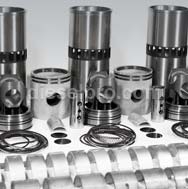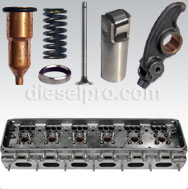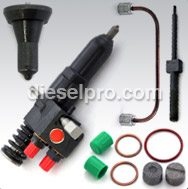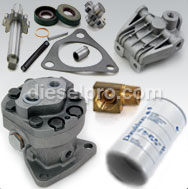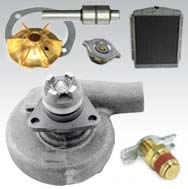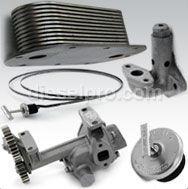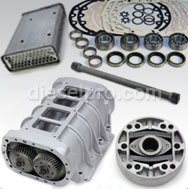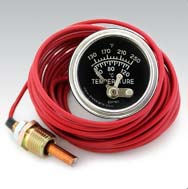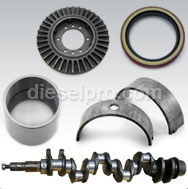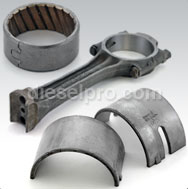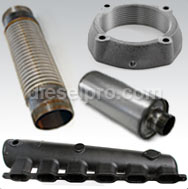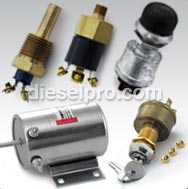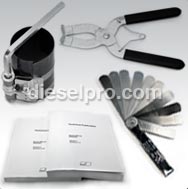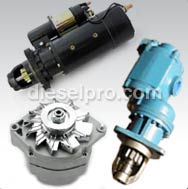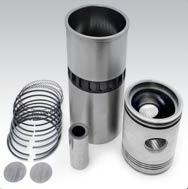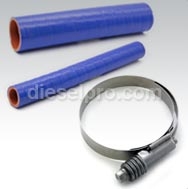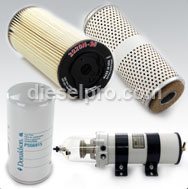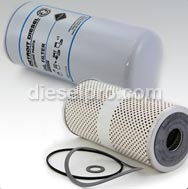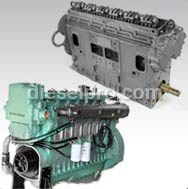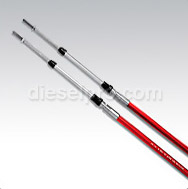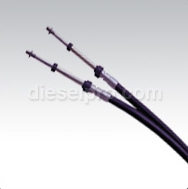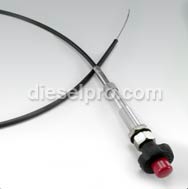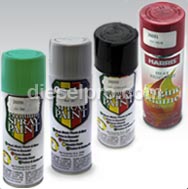The Detroit Diesel 6-71 Non-Turbo with 4-valve head is a refined version of one of the most trusted diesel engines in the world. As a member of the Series 71 family, the 6-71 inline six-cylinder engine has served in nearly every industrial, marine, military, and commercial application imaginable. The 4-valve head version, while still naturally aspirated via a Roots blower, provides a significant performance improvement over the older 2-valve design—offering enhanced airflow, better combustion, improved fuel economy, and cleaner operation. At Diesel Pro Power, we provide full aftermarket support for the Detroit 6-71 4-valve non-turbo engine, including overhaul kits, cylinder heads, injectors, water pumps, gaskets, fuel system parts, and cooling system components. This guide presents in-depth technical specifications and a breakdown of real-world applications where the 6-71 non-turbo 4-valve engine continues to perform reliably. Engine Type: Two-stroke inline diesel Number of Cylinders: 6 Displacement: 426 cubic inches (6.99 liters) Bore x Stroke: 4.25 in x 5.00 in (108 mm x 127 mm) Aspiration: Roots-type blower (no turbocharger) Cylinder Head: 4 valves per cylinder (2 intake, 2 exhaust) Compression Ratio: Approximately 17:1 Crankshaft Bearings: 7 main bearings Firing Order: 1-5-3-6-2-4 Rotation Options: Standard or opposite rotation (marine variants) Dry Weight: ~2,150 to 2,350 lbs depending on configuration This engine uses a Roots blower for forced induction, enabling it to function as a naturally aspirated system while maintaining consistent airflow through its 4-valve-per-cylinder configuration. The 4-valve head provides greater volumetric efficiency than the earlier 2-valve version, especially at higher RPMs. Fuel System: Mechanical unit injectors (one per cylinder) Injector Sizes: Typically N60 or N65 for 4-valve setups Fuel Consumption: ~0.44 lb/HP/hr under load Governor Type: Variable or fixed-speed mechanical governors Air Intake: Blower-charged intake through dual intake ports Valve Train: Pushrod actuated, overhead valve design with four valves per cylinder Intake/Exhaust Flow: Cross-flow design for efficient scavenging The 4-valve layout offers better cylinder filling and exhaust evacuation, leading to increased horsepower and torque, improved fuel efficiency, and more complete combustion compared to the 2-valve variant. Horsepower Range: 210 to 238 HP @ 2,100 RPM Peak Torque: 475 to 525 lb-ft @ 1,200 to 1,600 RPM Rated Speed: 2,100 RPM (adjustable to 2,300 RPM with governor modifications) Idle Speed: 600–650 RPM Air-to-Fuel Ratio: ~18:1 The 6-71 with 4-valve head delivers performance close to that of early turbocharged models, without requiring a turbo. This makes it a popular option for operators who want a non-turbo solution with enhanced output and reliability. Oil Type: SAE 40 (preferred), or 15W-40 multigrade for wide temperature swings Oil Capacity: Approximately 5.5 to 6 gallons (20.8 to 22.7 liters) Oil Pressure (Normal): 40 to 60 psi Cooling System Type: Water-cooled block with heat exchanger or direct keel cooling Coolant Capacity: 4 to 5 gallons (15 to 19 liters) Water Pump: Gear-driven centrifugal pump Operating Temperature: 170°F to 190°F (regulated by thermostats) This configuration is particularly reliable in marine and stationary industrial environments, where consistent temperature and lubrication are critical for long hours of operation. The 6-71 4-valve non-turbo engine is valued across industries for its enhanced airflow, fuel efficiency, and manageable power band, all while maintaining the simplicity of a non-turbocharged platform. The extra valve area in each cylinder enables more complete combustion, better exhaust evacuation, and a cleaner-running engine overall. In the marine sector, the 6-71 4-valve naturally aspirated engine is commonly found in vessels that prioritize reliability, mechanical simplicity, and moderate horsepower. Coastal fishing vessels and longliners Charter fishing and dive boats Inshore shrimpers Small pilot and harbor patrol boats River ferries and water taxis Older trawlers and converted working boats With a typical output of 210–230 HP, this engine is often paired with Twin Disc or Allison marine transmissions, allowing it to operate efficiently in single or twin-engine configurations. It’s particularly suited for harbor maneuvering and long idle periods followed by periods of steady cruising. Due to its fuel economy and consistent torque curve, the 6-71 non-turbo 4-valve engine is well-suited for industrial power generation and mechanical drive systems. Generator sets (prime and standby configurations) Water and slurry pumping stations High-capacity fire pump systems for refineries Material conveyor systems Crushers and screening plants in quarry operations Oilfield support rigs and winch systems This engine continues to see use in remote operations where electronics are not welcome, and mechanical reliability is non-negotiable. Its 4-valve design provides just enough edge in airflow and efficiency to outperform the older 2-valve setup under variable industrial loads. The 6-71N 4-valve was a factory option in a number of commercial transportation and municipal service platforms. It offered additional torque and fuel economy for fleets that operated in city environments or required more robust load-hauling capabilities. Transit and intercity buses (GM PD4106, PD4903, etc.) Fire engines (especially with front-mount pumps) Dump trucks and refuse haulers Cement mixers Army transport and engineering vehicles Airport tugs and ground support equipment Many of these units are still in use in South America, Southeast Asia, and other regions where repowered buses and military surplus trucks are popular. Given its durability and nostalgic status, the 6-71 4-valve naturally aspirated version is frequently used in restoration projects and specialty repowers. Classic working boat restorations Vintage GM, Flxible, or MCI buses Custom overland expedition trucks Industrial museum and display engines Repowered oilfield service trucks Engine swaps into military surplus vehicles Builders prefer the 4-valve head when they want to preserve the classic 6-71 sound and feel while gaining improved performance without stepping into the complexity of turbocharged configurations. Feature Specification Engine Type Inline 6-cylinder, 2-stroke diesel Valve Configuration 4 valves per cylinder Displacement 426 cubic inches (6.99 liters) Aspiration Roots blower (no turbocharger) Horsepower Range 210–238 HP @ 2,100 RPM Peak Torque 475–525 lb-ft @ 1,200–1,600 RPM Fuel System Mechanical unit injectors Oil Capacity 5.5–6 gallons (20.8–22.7 liters) Coolant Capacity 4–5 gallons (15–19 liters) Operating Temperature 170°F–190°F Typical Applications Fishing vessels, fire pumps, gensets, buses, winches Enhanced Power Output without the complexity of a turbo Improved Fuel Efficiency and combustion versus 2-valve design Consistent Performance across load ranges Reliable Cold Starts and cleaner operation Compatible with Existing Parts and rebuild infrastructure Globally Supported with readily available aftermarket components Lower overall output than the 6-71 turbo version Still requires blower maintenance Large physical footprint compared to modern engines May require transmission gearing adjustment when repowering Marine Detroit Diesel 6-71 Component Maintenance Life Engine Components and Their Roles (Covering Detroit Diesel 271, 371, 471, 671 Engines) Key Maintenance Procedures (Covering Detroit Diesel 271, 371, 471, 671 Engines) Assembly and Disassembly Guidelines (Covering Detroit Diesel 271, 371, 471, 671 Engines) Safety Protocols for Technicians (Working On Detroit Diesel 271, 371, 471, 671 Engines) Torque Specifications And Wear Limits (Covering Detroit Diesel 271, 371, 471, 671 Engines) Disassembly Of Throttle Controls For Detroit Diesel 71 Series Inline Engine (271, 371, 471, 671) DISASSEMBLY OF AIR BOX COVERS FOR DETROIT DIESEL 71 SERIES INLINE ENGINES (271, 371, 471, 671) Disassembly Of The Blower For Detroit Diesel 71 Series Inline Engine (271, 371, 471, 671) Removing Air Box Drains For Detroit Diesel 71 Series Inline Engines (271, 371, 471, 671) REMOVING THE VALVE ROCKER COVER ON A DETROIT DIESEL 71 SERIES INLINE ENGINE (271, 371, 471, 671) Torque Specifications Of 71 Series Inline Engines (271, 371, 471, 671) Disassembly Of Components For Detroit Diesel 71 Series Inline Engines (271, 371, 471, 671) Key Components of the Oil Pump and Model-Specific Variations (271, 371, 471, 671) INSIGHTS FROM THE DETROIT DIESEL 71 SERIES INLINE ENGINE MANUAL VOLUME 2 (271, 371, 471, 671) LUBRICATION SYSTEM FOR DETROIT DIESEL 71 SERIES INLINE ENGINES (271, 371, 471, 671) Disassembly of the Oil Pump For Detroit Diesel 71 Series Inline Engines (271, 371, 471, 671) Reassembly of the Oil Pump For Detroit Diesel 71 Series Inline Engines (271, 371, 471, 671) Oil Filters For Detroit Diesel 71 Series Inline Engines (271,371, 471, 671) LUBRICATING OIL PRESSURE REGULATOR FOR DETROIT DIESEL 71 SERIES INLINE ENGINES (271, 371, 471, 671) Oil Cooler For Detroit Diesel 71 Series Inline Engines (271, 371, 471, 671) Oil Pan For Detroit Diesel 71 Series Inline Engines (271, 371, 471, 671) Ventilating System for Detroit Diesel 71 Series Inline Engines (271, 371, 471, 671) Oil Pump Maintenance For Detroit Diesel 71 Series Inline Engines (271, 371, 471, 671) Radiator Cooling For Detroit Diesel 71 Series Inline Engines (271, 371, 471, 671) Cooling System and Heat Exchanger For Detroit Diesel 71 Series Inline Engines (271, 371, 471, 671) Cooling System Configurations For 71 Series Inline Engines (271, 371, 471, 671) Types of Coolant for Detroit Diesel 71 Series Inline Engines (271, 371, 471, 671) Chemicals & Coolant For Your Detroit Diesel 71 Series Inline Engine (271, 371, 471, 671) Maintaining The Heat Exchanger Core For Detroit Diesel 71 Series Inline Engine (271, 371, 471, 671) Guidelines for Coolant For Detroit 71 Series Inline Engines (271, 371, 471, 671) Introduction to the Water Pump System for the 71 Series Inline Engine (271, 371, 471, 671) Disassembly of the Freshwater Pump For Detroit Diesel 71 Series Inline Engines (271, 371, 471, 671) Reassembly of the Freshwater Pump For Detroit Diesel 71 Series Inline (271, 371, 471, 671) Freshwater Pump Maintenance For Detroit Diesel 71 Series Inline Engines (271, 371, 471, 671) Raw Water Pump Maintenance (Marine Application) For 71 Series Inline Engines (271, 371, 471, 671) Disassembly of the Raw Water Pump For Detroit Diesel 71 Series Inline Engines (271, 371, 471, 671) Reassembly of the Raw Water Pump For Detroit Diesel 71 Series Inline Engines (271, 371, 471, 671) Water Pump For Detroit Diesel 71 Series Inline Engines (271, 371, 471, 671) Thermostat Operation For Detroit Diesel 71 Series Inline Engines (271, 371, 471, 671) SYSTEMATIC APPROACH TO TROUBLESHOOTING DETROIT DIESEL 71 SERIES INLINE ENGINES (271, 371, 471, 671) Cooling System Troubleshooting For Detroit Diesel 71 Series Inline Engines (271, 371, 471, 671) Troubleshooting Tips for Improved Efficiency In Detroit Diesel 71 Series Inline Engines (271, 371, 471, 671) Detroit Diesel 271,371,471,671 Inline Engine Tune Up Guide Disassembly Turbocharger (If Equipped) For Detroit Diesel 71 Series Inline Engines (471, 671) Disassembly Of Turbochargers For Detroit Diesel 71 Series Inline Engines – (471, 671)
Parts for Detroit Diesel 671 Non-Turbo - (4 Valve Head Type)
-
Select Parts Category
 Loading...
Loading... Detroit Diesel 6-71 Non-Turbo – 4-Valve Head Type – Engine Specifications & Applications
Overview
Engine Specifications – Detroit Diesel 6-71 Non-Turbo, 4-Valve Head
Core Engine Architecture
Fuel and Air Management
Power and Performance Ratings
Lubrication and Cooling System
Applications of the Detroit Diesel 6-71 Non-Turbo – 4-Valve Head
Marine Applications
Typical Marine Use Cases
Industrial and Stationary Applications
Common Industrial Uses
Ground-Based Vehicles and Utility Equipment
Common Vehicle Applications
Restoration, Repowers, and Custom Installs
Popular Restoration Uses
Summary Table – Detroit Diesel 6-71 Non-Turbo, 4-Valve Head
Why Choose the 6-71 4-Valve Naturally Aspirated Engine
Advantages
Considerations
Additional Resources
The Legacy of the Detroit Diesel Marine 671 Engine & Its Use Today
Detroit Diesel 6-71 Marine Engine Specifications (2 Valve, 4 Valve Non-Turbo & Turbo)
The History of the Detroit Diesel 671 Quad Engine Setup
Assembling The Detroit Diesel 671 Long Block
Aftermarket Parts For Detroit Diesel 671 Engines
Everything You Need to Know About the Detroit Diesel 671 Blower
Practical Guide To Servicing Your Detroit Diesel 71 Series Inline (271, 371, 471, & 671 ) – Part 1
AIR SCAVENGING AND BLOWER SYSTEM FOR DETROIT DIESEL 71 SERIES INLINE ENGINES (271, 371, 471, 671)
Best Practices for Keeping Air Intake and Exhaust Systems Clean For Detroit Diesel 71 Series Inline Engines (271, 371, 471, 671)
Cleaning and Inspection Processes For Detroit Diesel 71 Series Inline Engines (271, 371, 471, 671)
Safe Cleaning Procedures Detroit Diesel 71 Series Inline Engine (271, 371, 471, 671)
Critical Inspection Points For Detroit Diesel 71 Series Inline Engines (271, 371, 471, 671)
Valve and Injector Maintenance For Detroit Diesel 71 Series Inline Engines (271, 371, 471, 671)
Checking Valve Clearance and Injector Timing For Detroit Diesel 71 Series Inline Engines (271, 371, 471, 671)
Tools and Equipment For Maintaining Detroit Diesel 71 Series Inline Engines (271, 371, 471, 671)
Detailed Overhaul Process For Detroit Diesel 71 Series Inline Engine (271, 371, 471, 671)
Common Troubleshooting Tips For Detroit Diesel 71 Series Inline Engines (271, 371, 471, 671)
Disassembly Of Fuel Lines For Detroit Diesel 71 Series Inline Engines (271, 371, 471, 671)
Disassembly Of Exhaust Manifold For Detroit Diesel 71 Series Inline Engines (271, 371, 471, 671)
Disassembling The Air Cleaner & The Air Shutdown Housing For Detroit Diesel 71 Series Inline Engines (271, 371, 471, 671)
Summary of Troubleshooting and Specifications In Detroit Diesel 71 Series Inline Engines (271, 371, 471, 671)
FAQ From Detroit Diesel 71 Series Inline Engine Service Manual (271, 371, 471, 671)



 Free US Calls: 1-888-433-4735
Free US Calls: 1-888-433-4735 International: 305-545-5588
International: 305-545-5588





